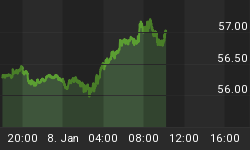
Better Than Expected In Midwest
When the Fed governors prepare to turn in for the night, their prayers undoubtedly call for some improvement in the economy. As noted Monday, the Fed is hoping the economic coals will take over allowing them to put away their lighter fluid. Thursday gave the Fed governors some reason to hope. From Reuters:
Business activity in the U.S. Midwest surged past expectations in October as new orders hit their highest level since 2004, countering recent evidence of soft economic growth. Weekly unemployment claims also fell, in welcome news for the nation's battered labor market after the impact of a government shutdown on furloughed federal workers diminished. The Institute for Supply Management-Chicago business barometer jumped to 65.9 from 55.7, the strongest reading since March 2011 and well above the most optimistic forecast in a Reuters poll.
Interest Rates Trying To Turn Back Up
The better than expected news from middle America was making defensive assets less attractive to investors. As of Thursday at 1:00 p.m. ET, bonds were down for the week, with Treasuries (TLT) falling 0.88% and a more diversified basket of fixed income instruments (AGG) giving back 0.16%. When bond prices fall, interest rates rise.
The chart below shows the widely followed interest rate being paid by 10-year Treasuries, which is something we will be keeping an eye on in the coming days and weeks. When interest rates held near point A, the S&P 500 (at bottom) posted some nice gains. Conversely, when interest rates dropped near point B, stocks went through a corrective period. The present day, point C, appears to be holding similar to A, but the look could change.

Taper Expectations Reeled Back In

Heading into Wednesday's Fed meeting Wall Street expected the first tapering event to take place in March 2014. The portions of the Fed's statement below may have sent a more hawkish message to the markets:
The Committee sees the downside risks to the outlook for the economy and the labor market as having diminished, on net, since last fall...Taking into account the extent of federal fiscal retrenchment over the past year, the Committee sees the improvement in economic activity and labor market conditions since it began its asset purchase program as consistent with growing underlying strength in the broader economy...To support continued progress toward maximum employment and price stability, the Committee today reaffirmed its view that a highly accommodative stance of monetary policy will remain appropriate for a considerable time after the asset purchase program ends and the economic recovery strengthens.
Consequently, the Street has reassessed their tapering expectations. From Bloomberg:
Economists at Citigroup Inc. and Barclays Plc said yesterday's Fed policy statement opens the possibility of reduced bond purchases as soon as December. The odds of a taper in January rose to 45 percent, from 25 percent before the decision, according to Citigroup. Economists surveyed by Bloomberg Oct. 17-18 had predicted the Fed would begin paring stimulus in March.
Investment Implications - Indecisive, But Still Bullish
The last two weeks have seen a pause in the market's confidence regarding future economic outcomes, which is impacted by the Fed's desire to slow the printing presses. When the aggregate economic outlook of investors is favorable, asset prices tend to rise. The current pause is noteworthy, but has not yet morphed into anything that calls for allocation changes. The S&P 500 was up 4 points for the week during Thursday's session. If investor fear picks up, a red week is still well within reach. Given what we know today, the game plan is to ride out any short-term corrective activity, allowing us to maintain exposure to U.S. stocks (SPY), technology (QQQ), and foreign stocks (EFA). If the recent pause provides a launching pad for a shift from bullish economic conviction to economic fear, we stand ready to make allocation adjustments in line with the magnitude of the shift in sentiment.
















